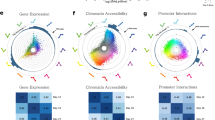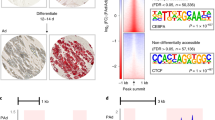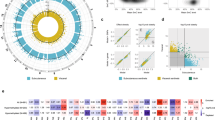Abstract
Objectives:
With ENCODE epigenomic data and results from published genome-wide association studies (GWASs), we aimed to find regulatory signatures of obesity genes and discover novel susceptibility genes.
Methods:
Obesity genes were obtained from public GWAS databases and their promoters were annotated based on the regulatory element information. Significantly enriched or depleted epigenomic elements in the promoters of obesity genes were evaluated and all human genes were then prioritized according to the existence of the selected elements to predict new candidate genes. Top-ranked genes were subsequently applied to validate their associations with obesity-related traits in three independent in-house GWAS samples.
Results:
We identified RAD21 and EZH2 as over-represented, and STAT2 (signal transducer and activator of transcription 2) and IRF3 (interferon regulatory transcription factor 3) as depleted transcription factors. Histone modification of H3K9me3 and chromatin state segmentation of 'poised promoter' and 'repressed' were over-represented. All genes were prioritized and we selected the top five genes for validation at the population level. Combining results from the three GWAS samples, rs7522101 in ESRRG (estrogen-related receptor-γ) remained significantly associated with body mass index after multiple testing corrections (P=7.25 × 10−5). It was also associated with β-cell function (P=1.99 × 10−3) and fasting glucose level (P<0.05) in the meta-analyses of glucose and insulin-related traits consortium (MAGIC) data set.
Cnoclusions:
In summary, we identified epigenomic characteristics for obesity genes and suggested ESRRG as a novel obesity-susceptibility gene.
This is a preview of subscription content, access via your institution
Access options
Subscribe to this journal
Receive 12 print issues and online access
$259.00 per year
only $21.58 per issue
Buy this article
- Purchase on Springer Link
- Instant access to full article PDF
Prices may be subject to local taxes which are calculated during checkout


Similar content being viewed by others
References
Kelly T, Yang W, Chen CS, Reynolds K, He J . Global burden of obesity in 2005 and projections to 2030. Int J Obes (Lond) 2008; 32: 1431–1437.
Stunkard AJ, Foch TT, Hrubec Z . A twin study of human obesity. JAMA 1986; 256: 51–54.
Turula M, Kaprio J, Rissanen A, Koskenvuo M . Body weight in the Finnish Twin Cohort. Diabetes Res Clin Pract 1990; 10 (Suppl 1): S33–S36.
Selby JV, Newman B, Quesenberry CP Jr, Fabsitz RR, King MC, Meaney FJ . Evidence of genetic influence on central body fat in middle-aged twins. Hum Biol 1989; 61: 179–194.
Rose KM, Newman B, Mayer-Davis EJ, Selby JV . Genetic and behavioral determinants of waist–hip ratio and waist circumference in women twins. Obes Res 1998; 6: 383–392.
Malis C, Rasmussen EL, Poulsen P, Petersen I, Christensen K, Beck-Nielsen H et al. Total and regional fat distribution is strongly influenced by genetic factors in young and elderly twins. Obes Res 2005; 13: 2139–2145.
Fall T, Ingelsson E . Genome-wide association studies of obesity and metabolic syndrome. Mol Cell Endocrinol 2014; 382: 740–757.
Locke AE, Kahali B, Berndt SI, Justice AE, Pers TH, Day FR et al. Genetic studies of body mass index yield new insights for obesity biology. Nature 2015; 518: 197–206.
Shungin D, Winkler TW, Croteau-Chonka DC, Ferreira T, Locke AE, Magi R et al. New genetic loci link adipose and insulin biology to body fat distribution. Nature 2015; 518: 187–196.
Manolio TA, Collins FS, Cox NJ, Goldstein DB, Hindorff LA, Hunter DJ et al. Finding the missing heritability of complex diseases. Nature 2009; 461: 747–753.
Lee SH, Wray NR, Goddard ME, Visscher PM . Estimating missing heritability for disease from genome-wide association studies. Am J Hum Genet 2011; 88: 294–305.
Chadwick LH . The NIH Roadmap Epigenomics Program data resource. Epigenomics 2012; 4: 317–324.
Rosenbloom KR, Sloan CA, Malladi VS, Dreszer TR, Learned K, Kirkup VM et al. ENCODE data in the UCSC Genome Browser: year 5 update. Nucleic Acids Res 2013; 41: D56–D63.
American Association for Cancer Research Human Epigenome Task F. European Union NoESAB. Moving AHEAD with an international human epigenome project. Nature 2008; 454: 711–715.
Consortium EP.. The ENCODE (ENCyclopedia Of DNA Elements) Project. Science 2004; 306: 636–640.
Consortium EP. An integrated encyclopedia of DNA elements in the human genome. Nature 2012; 489: 57–74.
Herrera BM, Keildson S, Lindgren CM . Genetics and epigenetics of obesity. Maturitas 2011; 69: 41–49.
Stoger R . Epigenetics and obesity. Pharmacogenomics 2008; 9: 1851–1860.
Arora P . Obesity genetics and epigenetics: dissecting causality. Circ Cardiovasc Genet 2014; 7: 395–396.
Dozmorov MG, Wren JD, Alarcon-Riquelme ME . Epigenomic elements enriched in the promoters of autoimmunity susceptibility genes. Epigenetics 2014; 9: 276–285.
Welter D, MacArthur J, Morales J, Burdett T, Hall P, Junkins H et al. The NHGRI GWAS Catalog, a curated resource of SNP-trait associations. Nucleic Acids Res 2014; 42: D1001–D1006.
Subramanian A, Tamayo P, Mootha VK, Mukherjee S, Ebert BL, Gillette MA et al. Gene set enrichment analysis: a knowledge-based approach for interpreting genome-wide expression profiles. Proc Natl Acad Sci USA 2005; 102: 15545–15550.
Yang TL, Guo Y, Li SM, Li SK, Tian Q, Liu YJ et al. Ethnic differentiation of copy number variation on chromosome 16p12.3 for association with obesity phenotypes in European and Chinese populations. Int J Obes (Lond) 2013; 37: 188–190.
Yang TL, Guo Y, Li J, Zhang L, Shen H, Li SM et al. Gene–gene interaction between RBMS3 and ZNF516 influences bone mineral density. J Bone Miner Res 2013; 28: 828–837.
Deng HW, Deng H, Liu YJ, Liu YZ, Xu FH, Shen H et al. A genomewide linkage scan for quantitative-trait loci for obesity phenotypes. Am J Hum Genet 2002; 70: 1138–1151.
Purcell S, Neale B, Todd-Brown K, Thomas L, Ferreira MA, Bender D et al. PLINK: a tool set for whole-genome association and population-based linkage analyses. Am J Hum Genet 2007; 81: 559–575.
Howie BN, Donnelly P, Marchini J . A flexible and accurate genotype imputation method for the next generation of genome-wide association studies. PLoS Genet 2009; 5: e1000529.
Marchini J, Howie B, Myers S, McVean G, Donnelly P . A new multipoint method for genome-wide association studies by imputation of genotypes. Nat Genet 2007; 39: 906–913.
Rivera CM, Ren B . Mapping human epigenomes. Cell 2013; 155: 39–55.
Ernst J, Kheradpour P, Mikkelsen TS, Shoresh N, Ward LD, Epstein CB et al. Mapping and analysis of chromatin state dynamics in nine human cell types. Nature 2011; 473: 43–49.
Dupuis J, Langenberg C, Prokopenko I, Saxena R, Soranzo N, Jackson AU et al. New genetic loci implicated in fasting glucose homeostasis and their impact on type 2 diabetes risk. Nat Genet 2010; 42: 105–116.
Manning AK, Hivert MF, Scott RA, Grimsby JL, Bouatia-Naji N, Chen H et al. A genome-wide approach accounting for body mass index identifies genetic variants influencing fasting glycemic traits and insulin resistance. Nat Genet 2012; 44: 659–669.
Wang L, Jin Q, Lee JE, Su IH, Ge K . Histone H3K27 methyltransferase Ezh2 represses Wnt genes to facilitate adipogenesis. Proc Natl Acad Sci USA 2010; 107: 7317–7322.
Wang L, Huang J, Jiang M, Lin H . Signal transducer and activator of transcription 2 (STAT2) metabolism coupling postmitotic outgrowth to visual and sound perception network in human left cerebrum by biocomputation. J Mol Neurosci 2012; 47: 649–658.
Wang XA, Zhang R, She ZG, Zhang XF, Jiang DS, Wang T et al. Interferon regulatory factor 3 constrains IKKbeta/NF-kappaB signaling to alleviate hepatic steatosis and insulin resistance. Hepatology 2014; 59: 870–885.
Ernst J, Kellis M . Discovery and characterization of chromatin states for systematic annotation of the human genome. Nat Biotechnol 2010; 28: 817–825.
Li Q, Li N, Hu X, Li J, Du Z, Chen L et al. Genome-wide mapping of DNA methylation in chicken. PLoS One 2011; 6: e19428.
Kubo M, Ijichi N, Ikeda K, Horie-Inoue K, Takeda S, Inoue S . Modulation of adipogenesis-related gene expression by estrogen-related receptor gamma during adipocytic differentiation. Biochim Biophys Acta 2009; 1789: 71–77.
Alaynick WA, Kondo RP, Xie W, He W, Dufour CR, Downes M et al. ERRgamma directs and maintains the transition to oxidative metabolism in the postnatal heart. Cell Metab 2007; 6: 13–24.
Alaynick WA, Way JM, Wilson SA, Benson WG, Pei L, Downes M et al. ERRgamma regulates cardiac, gastric, and renal potassium homeostasis. Mol Endocrinol 2010; 24: 299–309.
Rangwala SM, Wang X, Calvo JA, Lindsley L, Zhang Y, Deyneko G et al. Estrogen-related receptor gamma is a key regulator of muscle mitochondrial activity and oxidative capacity. J Biol Chem 2010; 285: 22619–22629.
Kelley DE, He J, Menshikova EV, Ritov VB . Dysfunction of mitochondria in human skeletal muscle in type 2 diabetes. Diabetes 2002; 51: 2944–2950.
Morino K, Petersen KF, Shulman GI . Molecular mechanisms of insulin resistance in humans and their potential links with mitochondrial dysfunction. Diabetes 2006; 55 (Suppl 2): S9–S15.
Yoo JK, Jung HY, Kim CH, Son WS, Kim JK . miR-7641 modulates the expression of CXCL1 during endothelial differentiation derived from human embryonic stem cells. Arch Pharm Res 2013; 36: 353–358.
Nunemaker CS, Chung HG, Verrilli GM, Corbin KL, Upadhye A, Sharma PR . Increased serum CXCL1 and CXCL5 are linked to obesity, hyperglycemia, and impaired islet function. J Endocrinol 2014; 222: 267–276.
Melen E, Himes BE, Brehm JM, Boutaoui N, Klanderman BJ, Sylvia JS et al. Analyses of shared genetic factors between asthma and obesity in children. J Allergy Clin Immunol 2010; 126: 631–7 e1-8.
Kim MJ, Park SK, Lee JH, Jung CY, Sung DJ, Park JH et al. Salt-inducible kinase 1 terminates cAMP signaling by an evolutionarily conserved negative-feedback loop in beta-cells. Diabetes 2015; 64: 3189–3202.
Wen W, Zheng W, Okada Y, Takeuchi F, Tabara Y, Hwang JY et al. Meta-analysis of genome-wide association studies in East Asian-ancestry populations identifies four new loci for body mass index. Hum Mol Genet 2014; 23: 5492–5504.
Oliver PL, Chodroff RA, Gosal A, Edwards B, Cheung AF, Gomez-Rodriguez J et al. Disruption of Visc-2, a brain-expressed conserved long noncoding RNA, does not elicit an overt anatomical or behavioral phenotype. Cereb Cortex 2015; 25: 3572–3585.
Acknowledgements
This work was supported by National Natural Science Foundation of China (grant numbers 31371278, 31471188, 81573241 and 31511140285); China Postdoctoral Science Foundation (2015M570820); Natural Science Basic Research Program Shaanxi Province (2015JQ3089) and the Fundamental Research Funds for the Central Universities; and grants from National Institutes of Health (grant numbers P50AR055081, R01AG026564, R01AR050496 and R01AR057049).
Author information
Authors and Affiliations
Corresponding author
Ethics declarations
Competing interests
The authors declare no conflict of interest.
Additional information
Supplementary Information accompanies this paper on International Journal of Obesity website
Rights and permissions
About this article
Cite this article
Dong, SS., Guo, Y., Zhu, DL. et al. Epigenomic elements analyses for promoters identify ESRRG as a new susceptibility gene for obesity-related traits. Int J Obes 40, 1170–1176 (2016). https://doi.org/10.1038/ijo.2016.44
Received:
Revised:
Accepted:
Published:
Issue Date:
DOI: https://doi.org/10.1038/ijo.2016.44
This article is cited by
-
Skeletal muscle transcriptome in healthy aging
Nature Communications (2021)



